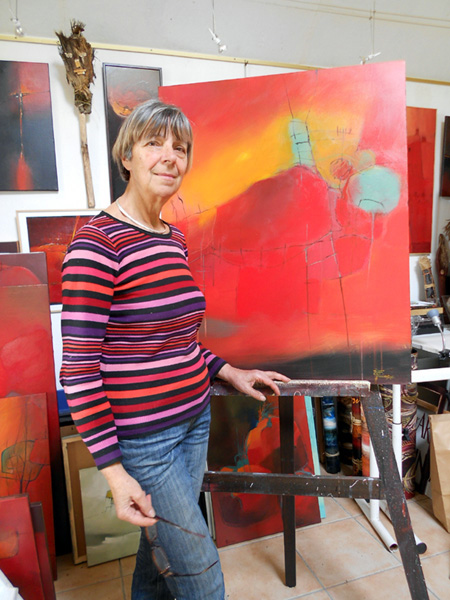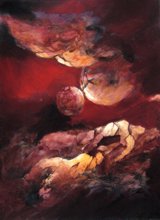|
Fabienne Quinsac
was the president of The Litterary and Artistic Society of Orléans, the
vice-president of the artistic group Traits abstraits (Abstract Lines),
and founding member
of two other artist societes, among others...
|
FROM WATERCOLOR TO ABSTRACTION
"Trying to
be myself,
with all the hazards it implies"

Fabienne QUINSAC (an alias for Marie-France
Maréchal) was born in 1940 in Dijon (Burgundy, France). She
heard the calling of art very soon, by leafing through art books at her
parents' home. Her mother, Renée, was teaching French, Greek and Latin in a high
school, and her father, Pierre, was a librarian with an expertise in old
French law, and working in Paris, a few steps from the Pantheon.
Fabienne Quinsac felt enthusiastic about abstract
painting and contemporary art. As a teenager, she would visit art
galleries and started to paint for herself. She was 21 when she took part
for the first time in a collective exhibition.
Fabienne was admitted at the famous Ecole Nationale Supérieure des Arts Décoratifs
(Ensad, commonly called
the "Arts Déco") in Paris and
graduated in 1968. She also felt concerned with the social and progressive
movements of the time, and always proudly defined herself as a feminist.
As a young painter, she believed that the classical, easel
painting was outdated. So she turned to architecture, then taught art in
secondary school - a way of imparting her passion and further her thinking
about the links between arts and society. But, with two kids (Olivier, now
an engineer, and
French author Fabien Maréchal) and her job,
she had very little time for painting.
In the late 1980's and early 1990's, when she
definitely left her job, she started to create again on a regular basis,
with a lot of experiments (air brush, mural, and even settings for the
International Chrysanthemum Exhibition in Orléans) and some watercolors that
immediately showed a very personal vision. In Fabienne's work, the
environment seems to be driven by a powerful inner strength, as if the
shadows of her most intimate questionings were hiding behind every tree, every
meander, every hill.
a violent romantism
Fabienne later explained : "I decided to
consider what I had learned as a kind of humus, and to forget the previous
questionings, so as to try to be myself, with all the hazards it implies :
accepting my qualities and faults, the hesitations and the fury to overcome
the work that resists."
In her more or less
figurative watercolors of the 1990's, she contrasted the influence of
classical architecture and the violent romanticism of big sailboats on
stormy seas, in a mix that reminds
Claude Monet
(Fabienne especially liked the
Water Lilies
series) and
William Turner. This unique style soon gained Fabienne a significant place in
the anthology
Watercolor and watercolorists in France.
Fabienne's work already showed a great ability
and maturity, with quick evolutions in technics, colors and subjects, with
more and more abstract representations.
At the turn of the century, she abandoned
watercolor and painted almost exclusively with
tar. The experiments to discover what this strange material had to offer
were essential to the artist. Tar was sometimes mixed with red earth, bronze
powder, watercolor or acrylic. The paintings then evoked the atmosphere of
supernatural tales, abandoned villages, barren mountains, impressive but
dislocated landscapes.
This had little to do with figurative painting.
Still, the visual power of Fabienne's works remained astonishingly evocative,
sometimes calling to mind
Gao Xingjian,
for instance in the Remnants and Volcanoes series.
Before the
mid-2000's, working with mixed technique,
acrylic painting prevailed, even if some
tar could remain here and there. Fabienne Quinsac's style got closer and
closer to informalism ("art informel"), that is, a representation that suggests but doesn't
show a latent theme, sometimes evoking
Zao
Wou-Ki in the shapes and movements (previously, Fabienne had even called one of her
paintings
Montagne de Zao Wou-Ki - Zao Wou-Ki's Mountain).
confronting herself
Then, from the mid 2000's, was the "all acrylic"
period, that was going to last until Fabienne's death. Architecture, movement
and light still took the lead, in a style sometimes not so different from
Nicolas de Staël. However, the artist's work was increasingly
bare, even in the use of color.
Fabienne tried to show very little, but only
what was essential - a way to confront herself.
 The
Planets and hellfires series (around
2007-2008) led to a turning point, with incredible technical virtuosity and
tremendous suggestivity. Fabienne worked on several colors, one by one, in
quick series (searching one's way? Okay! Making twice the same thing? No way!):
Black series, Grey and red,
Aprons, Days of
snow and ice. The
Planets and hellfires series (around
2007-2008) led to a turning point, with incredible technical virtuosity and
tremendous suggestivity. Fabienne worked on several colors, one by one, in
quick series (searching one's way? Okay! Making twice the same thing? No way!):
Black series, Grey and red,
Aprons, Days of
snow and ice.
The
Monochromes series showed
the culmination of her talent, with a rare and heartbreaking strength.
Fabienne Quinsac put down her brushes for good
on August 30th, 2013. The day she died, two acrylic paintings on canvas -two
masterpieces- were drying in her studio :
Rupture (Break-up) and
Incertitude / Absence (Uncertainty / Absence)...
|